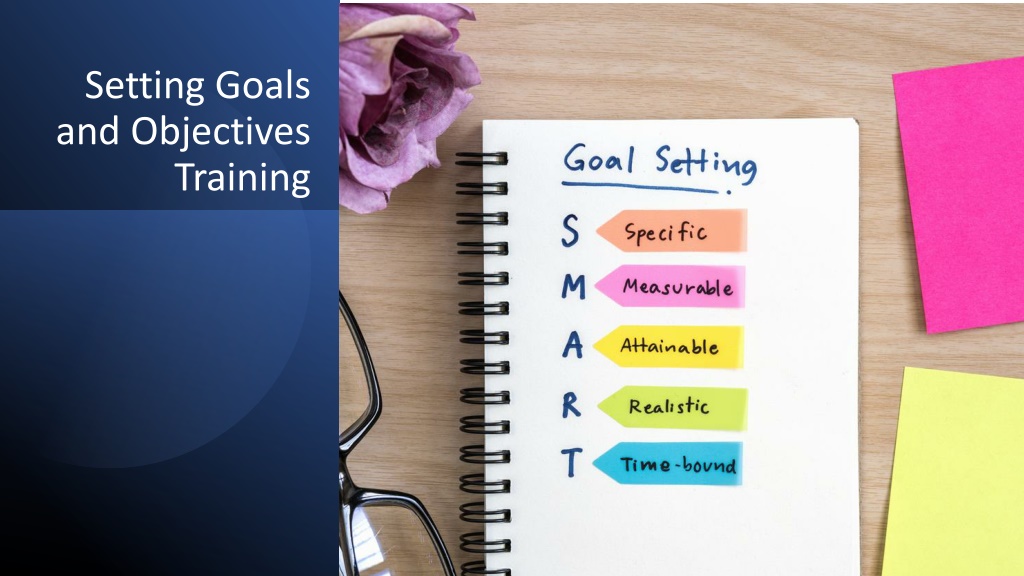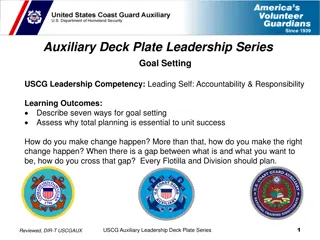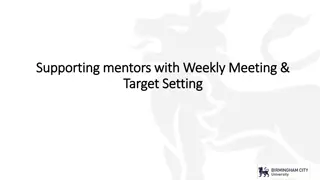Effective Goal Setting and Objectives Training
Setting goals and objectives is crucial in organizational planning. Goals provide the direction, while objectives act as milestones to track progress and maintain motivation. Learn about the difference between goals and objectives, setting SMART goals, and specific and measurable techniques in this comprehensive training.
Download Presentation

Please find below an Image/Link to download the presentation.
The content on the website is provided AS IS for your information and personal use only. It may not be sold, licensed, or shared on other websites without obtaining consent from the author.If you encounter any issues during the download, it is possible that the publisher has removed the file from their server.
You are allowed to download the files provided on this website for personal or commercial use, subject to the condition that they are used lawfully. All files are the property of their respective owners.
The content on the website is provided AS IS for your information and personal use only. It may not be sold, licensed, or shared on other websites without obtaining consent from the author.
E N D
Presentation Transcript
Setting Goals and Objectives Training
Setting Goals and Objectives Training WELCOME! 2
Introduction Setting goals and objectives is the first and most critical step in a company s planning process. Goals are forward-facing and provide the company with the direction in which it will move. Objectives can be mile markers along the road indicating progress and maintaining motivation. 3
Agenda The difference between goals and objectives. Setting SMART goals and objectives. How [company name] sets goals and objectives. Summary. 4
The Difference Between Goals and Objectives Goals define what should be accomplished while objectives define the actions needed to achieve the goal. Goals General Intangible Broad Abstract Strategic long-range direction, set by senior management Objectives Specific Measurable Narrow Tactical short-range, set by managers to support the accomplishment of goals 5
SMART Goals and Objectives When setting goals and objectives, use SMART criteria: Specific Measurable Achievable Relevant/Realistic Time-bound 7
SMART Goals and Objectives - Specific Specific goals and objectives are: Detailed Focused Well-defined Straightforward Action-oriented When setting objectives that are specific, ask the following questions: What am I going to do? Use action verbs such as develop, execute, conduct, and build. Why is it important to do this task? Who is going to be involved? When do I want this task to be completed? How am I going to do this task? 8
SMART Goals and Objectives - Measurable Measurements help you know you are making progress toward completing the objectives. Progress measurements also allow for course corrections along the way for both direction and pace. Objectives that are measurable provide tangible evidence of completion. When setting objectives that are measurable, ask the following questions: How will I know when this objective has been achieved? What measurements can I use? What milestones can I use to track progress toward completion? 9
SMART Goals and Objectives - Achievable Achievable objectives are those that can actually be accomplished (something that can realistically be done within the time frame set) not an aspiration or vision. Achievable objectives need to be challenging but not so much that they are unattainable or cause frustration in being unable to complete them. Full commitment is necessary to achieve the objectives. 10
SMART Goals and Objectives Relevant/Realistic When setting objectives that are relevant and realistic, ask the following questions: Realistic objectives are those that you have the resources to accomplish, including: Skills. Funding. Equipment. Time. Staff. How will pursuing this objective affect other performance objectives? Will this objective help meet/support department and company goals? Do I have the resources to accomplish this objective? If not, what additional resources are needed? Do I need to rearrange my priorities to accomplish this objective? 11
SMART Goals and Objectives Time-Focused Time-focused objectives are those that have realistic deadlines for completion. The time frames create a sense of urgency and lead to action. Complex objectives can be broken into small parts with deadlines set for completion of each phase. When setting objectives that are time-focused, ask the following questions: What are the earliest yet achievable and realistic dates for this objective to be started and to be completed? Have I included these dates in the statement of the objective? Are there other projects/objectives that must be completed first? Are other individuals or objectives reliant on the completion of this objective? 12
How We Set Goals and Objectives At [Company Name], senior management refines our corporate goals for the next three to five years on an annual basis as part of the company s strategic planning process. Under our management by objectives (MBO) process, individual managers use these corporate goals to set their departmental objectives and their own objectives, and they collaborate with employees to help develop employees individual objectives. We evaluate the performance of managers and employees based primarily on their accomplishment of these objectives. 14
Test Your Knowledge What is the difference between a goal and an objective? Why and how does [Company Name] set goals and objectives? What are SMART goals and objectives? 15
Summary Setting goals and objectives is the first and most critical step in the planning process. Although the terms goals and objectives are often used interchangeably, there are significant differences. The SMART acronym provides criteria to be used when setting goals and objectives. 16
Training Evaluation Please complete the training evaluation sheet included in the handouts. Thank you for your interest and attention! 18























